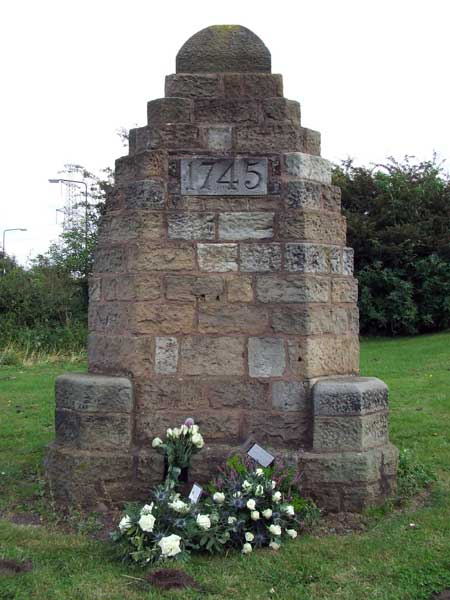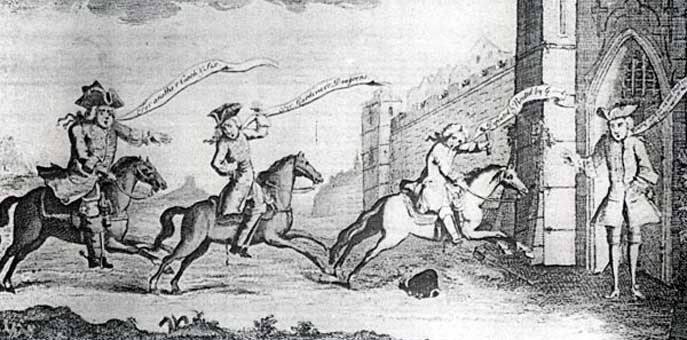THE BATTLE OF PRESTONPANS 1745 |
 |
Hanoverian General Cope landed at Dunbar on September 17, 1745. Along with approximately 2,500 troops he marched toward Edinburgh. With forces somewhat equal in number to the Jacobites, Cope decided to make a stand at Prestonpans and wait for Prince Charles Edward Stuart, who he knew would inevitably march to meet him in battle. The Hanoverian defensive position was thought to be ideal, with two stone walls on their right, a bog on their left, the sea behind and a deep moat-like ditch in front. In addition to Cope's well armed foot soldiers and dragoons were six 1 1/2 pounder galloper guns and six small mortars. Considering the Highlander's "poor" weapons (mismatched guns, broadswords, Lochaber axes, pitchforks...) and their lack of artillery, the English Commander was quite confident. The Jacobites came within sight of Cope's men by mid-afternoon, September 20 and paused to reconnoiter their offense and survey the area. Quartermaster and Adjutant-General John William O'Sullivan, a man neither respected nor liked by the Highland chiefs, sent a contingent of Camerons to the Tranent churchyard, at the village's northwestern extremity. Without delay they were observed by Cope's men, who used two of their 1 1/2 pounder guns to bombard them, wounding some. |
At this point Donald Cameron of Lochiel, XIX Captain and Chief of Clan Cameron became enraged that his men were being risked so and asked O'Sullivan's rival, the well thought of Lord George Murray to withdraw them. Over O'Sullivan's protests the Camerons were removed by Murray, who, acting on information that he had received, decided that the Jacobite attack must come from the east, not the west. Murray's decision, contrary to Prince Charles' plans, came about from information that he had received from a local gentleman, Robert Anderson. Anderson had known the area since childhood and told Murray of a hidden path through the unguarded bog, which would lead the Highlanders to the plain below. By this route they might take the Hanoverians by surprise. That evening, when the details of the impending attack were being finalized, a dangerous dispute took place between the Camerons and MacDonalds. Ever since the Battle of Bannockburn, with King Robert the Bruce in 1314, the honor of fighting on the right flank had belonged to the MacDonalds. This right was challenged by the Camerons. Earlier, because of a similar conflict, the Clan chiefs had arranged to settle such disputes by drawing lots. The outcome favored the Camerons. Unfortunately, the MacDonald fighting men erupted into near mutiny, essentially refusing to fight unless they were granted the right hand position. The situation was tactfully defused by Lochiel, who ceded the right flank to the MacDonalds if the battle didn't take place until the next day, which it didn't. |
 |
 |
The left flank, consisting of the Camerons, Stewarts of Appin, the Atholl Brigade and the MacGregors began a silent march toward the Hanoverian cannons and Colonel Gardiner's dragoons. Under Lord Murray's aggressive command the 800 Camerons were in action long before the rest of the Highland army, firing a few shots at the enemy ordinance guard as they advanced. The guard replied with two volleys, which did little to impede the Cameron's progress. At this point Colonel Whitefoord managed to fire off somewhere between five and eleven shots from the heavy mortars and 1 1/2 pounder guns, which killed one private and wounded an officer in Lochiel's regiment. This volley also killed Major James MacGregor, the son of the famous Rob Roy MacGregor. The artillery didn't intimidate the Camerons, it only managed to enrage them. They sounded their war cry "Chlanna nan con thigibh a so's gheibh sibh feoil" and "ran on with undaunted speed and were first up to the front of the enemy." At this point the right flank also streaked into action, charging the English and engaging them in the style of combat suited to the Highlander, hand-to-hand, with targes held firm. Incredibly, the action lasted only about fifteen minutes, ending in a total overthrow and almost entire destruction of Cope's army. The Camerons stayed in the thick of the battle during this time, engaging numerous pockets of Hanoverian foot soldiers, one of which Colonel Gardiner had attached himself to when his men fled for their lives. As he shouted "fire on my lads, and fear nothing," a Cameron dealt him a "terrible" blow to the head with his Lochaber axe, the ancient weapon of choice amongst Clan Cameron. Elsewhere the enemy forces were being decimated. Prince Charles was galloping across the battlefield, pleading with the Highlanders to stop killing the enemy, that they too were his father's subjects. Unfortunately, the majority of the soldiers only spoke Gaelic and couldn't understand the Prince nor any plea for mercy by the Hanoverians. "It would be far from true to say that none of the Highlanders gave quarter. The Camerons took many prisoners; so did Lord George Murray..." The Camerons gave many of Cope's men the chance to surrender with dignity after the obvious tide had been turned in battle. Lochiel himself authorized that the medicine chests, captured in Cope's baggage train, were to be utilized for Hanoverian wounded, possibly earning him for the first time the name "Gentle Lochiel." Very few Redcoats escaped. The number has been placed somewhere between 175 and 200, with General Cope leading their way to Berwick, where he was maligned as being the only General who had ever brought first news of his own defeat. Depending on whose official count one chooses to believe there were between 300 and 500 Hanoverians killed that early morning, approximately 1,400 were taken prisoner, of which 900 were wounded. Only about 40 Jacobites were killed and 75 wounded. Among the dead were two Cameron officers, Lieutenant Allan Cameron of Lundavra and Ensign James Cameron, both of Lochiel's regiment. |
 |
 |
© Paisley Tartan Army 2008-09
